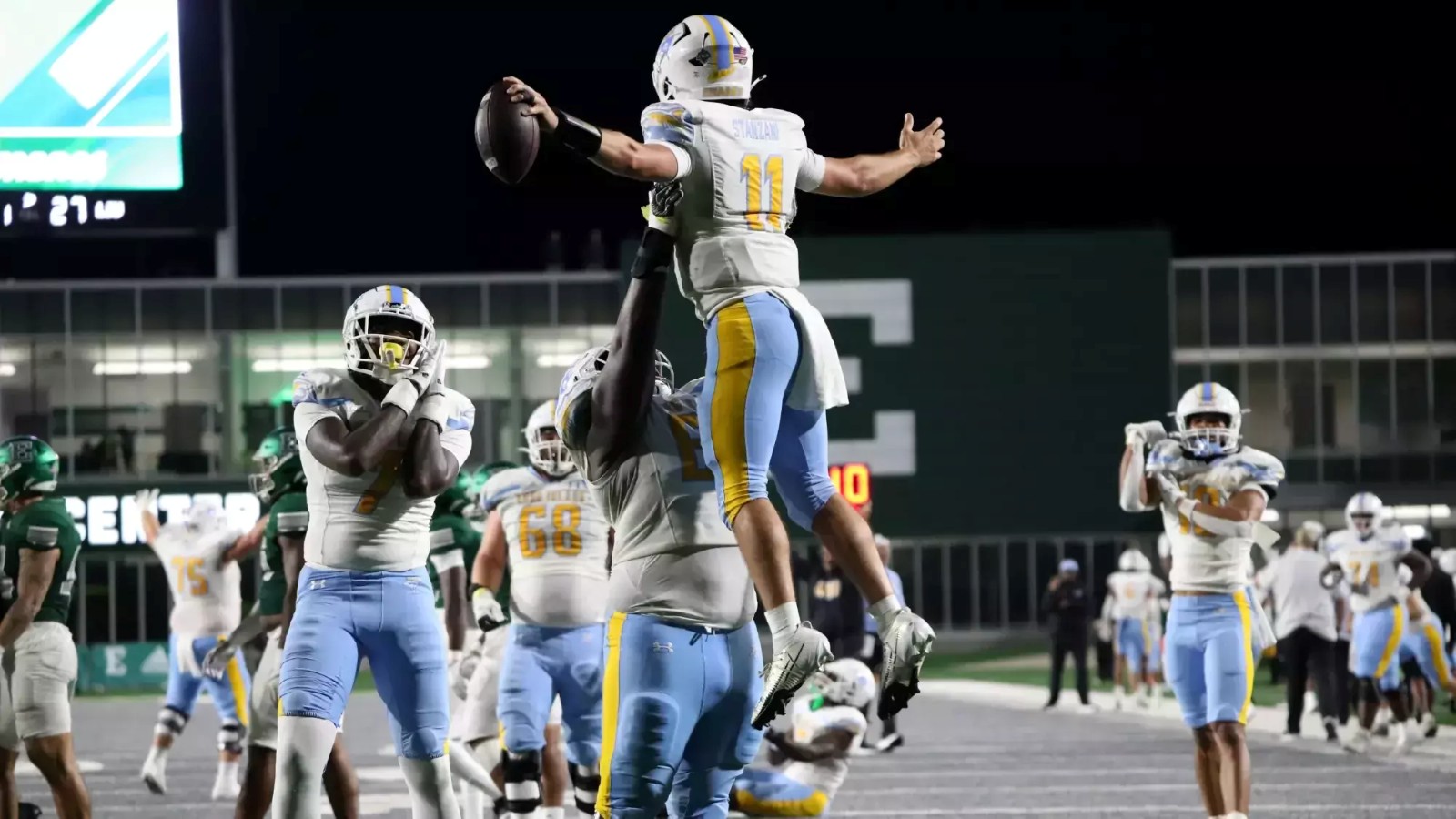Welcome to the last installment of the statistical dive into the FCS playoffs where all the information and charts are brought together to draw a few conclusions along with some parting words on what the future may hold. As a recap, the first four parts reviewed the entire playoffs from 1978 through 2023 followed by three separate eras of 1978 through 1992, 1993 through 2009, and 2010 through 2023. The entire series breakdown is provided below if you wish to jump to a specific section for more context and details. Let’s start by comparing each era based on the first three measures starting with the margin of victory.
Part 5 – Conclusion and Addendum
Measure #1 – Margin of Victory (by Era)
Measure #2 – Road versus Home and Worse Seeds versus Better Seeds
Measure #3 – Conference Composition in the Later Rounds
The Numbers! What Do They Mean?!
For 2010 through 2023, the average margin of victory across all games has never been higher, the average margin of victory in each round has never been higher, home teams have won more on average than the previous eras (particularly in semifinal games), home teams are winning by more on average than any other era, road teams are winning by less on average than any other era, and fewer conferences are participating in each round of the playoffs compared to other eras. The only two national championships to feature both teams from the same conference occurred in the Frisco era (the MVFC both times). By nearly every single measure above, there’s one noticeable takeaway: the Frisco era has been the *worst* era of the FCS playoffs.
Realignment’s Role in the Expanded Frisco Era
The topic of realignment has been briefly discussed in the first four parts of this series but the conclusion is a fitting place to have a more in-depth look. There’s no denying that the FCS has been raided by the FBS as teams naturally want to move up within the ever-shifting collegiate landscape. 9 different former FCS programs that combined to win 18 national titles (Delaware is included here) have moved to the FBS. That accounts for 39% of all the FCS national championships to date. Let’s look at a couple of charts that show how realignment has impacted the FCS over time.
In the first chart, the number of FCS playoff games lost is shown in blue for each year while the percentage of FCS playoff games played by I-AA/FCS members is shown in orange. Note that the chart starts in 1979 as the first playoffs were played in 1978. Only the games from preceding years are shown (i.e. 1979 only includes FCS playoff games in 1978, the 2000 season only includes FCS playoff games from 1978 through 1999, etc.).
The blue line is the total number of FCS playoff games that left the I-AA/FCS that year due to realignment. For example, Akron was the first team to leave I-AA in 1987 and they played 1 playoff game to that point. This is repeated for every season through 2025 when Delaware is slated to leave for the FBS. Finally, Idaho’s tenure in the FBS and subsequent return to the FCS are accounted for. From 1996 through 2017, Idaho’s playoff games to that point were removed. Starting in 2018, Idaho’s playoff games were added back in as the Vandals rejoined the FCS.
The chart above is a great representation of how many playoff games the FCS has lost due to realignment. There’s been a slow steady decline intertwined with larger losses as the stronger programs have left and this is most evident in 2014 when Appalachian State and Georgia Southern – two of the most successful FCS programs – left the Southern Conference to join the FBS’ Sun Belt Conference. Now let’s look at that same data another way: the number of appearances lost in the FCS playoffs by round.
Of course, we shouldn’t be surprised by the escalating numbers too much. Teams will naturally want to move up from the FCS if they’ve proven they can win consistently and it makes sense that the best teams would move up. The consistent loss of the best teams results in a power vacuum. Reviewing the first chart in this section shows that large spikes have occurred in the past; however, the three largest spikes of games lost will occur within an 11-year window (2014 through 2025). Finding quality programs to fill the void is a long process and one that can be undermined when additional teams leave for the FBS in a short time span as the CAA is witnessing with James Madison and Delaware.
Not only is the idea of FBS status alluring to teams, but there’s also been a constant reshuffling of teams within the FBS creating more and more opportunities for FCS programs to move. When the top conferences are making large, seismic changes, smaller programs start to wonder where they fit into the evolving landscape, which leads to FCS schools moving up while they can. It’s a vicious cycle that seems neverending and recent NCAA legal issues are likely to continue this feedback loop despite the NCAA’s recent attempts to slow the influx of FCS-to-FBS moves.
Back in part 4, it was noted that MVFC was a huge beneficiary of the realignment changes in the FCS. How many playoff games have the MVFC lost since 2010 when the Frisco era started? 18 games, all from Western Illinois, which has a grand total of 5 playoff games from 3 appearances since 2010 and those won’t actually count until the 2024 season gets underway when WIU officially joins the Big South-OVC in football. The MVFC has been a good conference for a long time but the combination of the Dakota State’s annual migration to Frisco and non-MVFC powerhouse programs leaving for the FBS left the door open for its clear emergence in the FCS. It also didn’t hurt that the Big Sky wasn’t able to capitalize on the same opportunity to contend for the top spot.
Will it be More of the Same or is There Hope for the Future?
One of the obvious questions is: what will the FCS playoffs look like in the future? Even the “closest” era of the FCS playoffs from 1978 through 1992 had an average margin of victory of 14 points, which some wouldn’t consider all that competitive. The issue is that the Frisco era has been marginally worse at 17 points but that small margin makes a huge difference. In football terms, it went from a two-score era to a three-score era. Despite everything presented above, there is optimism in the short term.
Why? With the latest ESPN and NCAA TV rights agreement, some of the issues surrounding hosting bids may be mitigated leading to more equal matchups in the early rounds. If additional seeds are allocated, that will create some transparency around the rankings. In the current 24-team playoff, only 8 seeds are allocated but we aren’t privy to how much weight certain factors impact those seedings. Are teams at the 7/8/9/10 line switched out to avoid rematches in the second round and quarterfinals? How much did the willingness to submit a host bid impact the seeding? Having access to those seeding pairs won’t necessarily guarantee more competitive matchups but it provides insight into how the committee views those teams near the 7 and 8 line and also provides a chance for further refinement in the future.
However, it’s not all hopeful in the long run mainly as a result of the unknown. The NCAA’s mounting legal issues threaten to cause a 1978-style reshaping of college athletics. Many have speculated that a Power 2 may be on the horizon leading to a three-tiered system of the Power 2, FBS, and FCS. There is undoubtedly a lot of uncertainty regarding how college sports – particularly football – will be administered in the future and the potential impact is not quantifiable without a concrete plan of action. There’s no stopping what’s headed the NCAA’s way and that’s one of the worrying aspects the FCS will have to face.
Photo Credit to North Dakota State University Athletics





